Brazil Geopolitics, An Emergent Economic Power’s Struggle with Geography
Politics / Brazil Aug 12, 2011 - 06:26 AM GMTBy: John_Mauldin
 Just last week in Thoughts from the Frontline, we discussed the relative valuations of emerging markets. Any discussion of an emerging market is incomplete without understanding the underlying geopolitical forces that guide behaviors of countries and often predetermine the outcome of events. Today I’m sending you STRATFOR’s geopolitical analysis of Brazil, a much-discussed emerging market. This is a long read, but it’s the most thorough and enlightening analysis I’ve seen thus far on how the continent’s geography has shaped Brazil’s history to date, and the major challenges the the country faces today. Hint: Brazil’s biggest problems are an overvalued "real," Mercosur, and an Asian giant (you guess which one…).
Just last week in Thoughts from the Frontline, we discussed the relative valuations of emerging markets. Any discussion of an emerging market is incomplete without understanding the underlying geopolitical forces that guide behaviors of countries and often predetermine the outcome of events. Today I’m sending you STRATFOR’s geopolitical analysis of Brazil, a much-discussed emerging market. This is a long read, but it’s the most thorough and enlightening analysis I’ve seen thus far on how the continent’s geography has shaped Brazil’s history to date, and the major challenges the the country faces today. Hint: Brazil’s biggest problems are an overvalued "real," Mercosur, and an Asian giant (you guess which one…).
For anyone considering an emerging market as an investment choice (or who is simply interested in world affairs), I highly recommend reading STRATFOR’s other geopolitical assessments, which they have on all the major players, including emerging markets. You can access these assessments, and all STRATFOR’s analysis and updates, when you subscribe. OTB readers can <<get a hefty discount on their subscriptions here>>. Their content is a valuable asset for any investor.
Your now considering samba lessons analyst,
John Mauldin
Outside the Box
JohnMauldin@2000wave.com
The Geopolitics of Brazil: An Emergent Power’s Struggle with Geography

Editor’s Note: This is the 15th in a series of STRATFOR monographs on the geopolitics of countries influential in world affairs.
Related Special Topic Page
South America is a geographically challenging land mass. The bulk of its territory is located in the equatorial zone, making nearly all of the northern two-thirds of its territory tropical. Jungle territory is the most difficult sort of biome to adapt for human economic activity. Clearing the land alone carries onerous costs. Soils are poor. Diseases run rampant. The climate is often too humid to allow grains to ripen. Even where rivers are navigable, often their banks are too muddy for construction, as with the Amazon.
As the tropics dominate South America, the continent’s economic and political history has been problematic. Venezuela, Guyana, Suriname and French Guiana are fully within the tropical zone, and as such always have faced difficulties in achieving economic and political stability, though the discovery of oil in Venezuela improved that country’s economic trajectory. Throughout the tropical zones nearly all of the population lives within a few dozen kilometers of the coast. For the most part, however, those coasts are not naturally sculpted to encourage interaction with the outside world. Natural ports — deepwater or otherwise — are few and far between.
There are, however, two geographic features on the continent that break this tropical monotony.
The first is the Andean mountain chain. The Andes run along the continent’s western edge, giving rise to a handful of littoral and transmountain cultures physically separated from the continent’s eastern bulk and thus largely left to develop according to their own devices. Colombia and Ecuador straddle the tropics and the Andes, with their economic cores not being coastal, but instead elevated in the somewhat cooler and dryer Andean valleys, which mitigates the difficulties of the tropics somewhat. Farther south are the arid transmountain states of Peru and Bolivia. Peru has achieved some degree of wealth by largely ignoring its own interior except when seeking resource extraction opportunities, instead concentrating its scant capital on the de facto city-state of Lima. In contrast, landlocked Bolivia is trapped in a perennial struggle between the poor highlanders of the Altiplano and the agriculturally rich region of the lowland Medialuna.
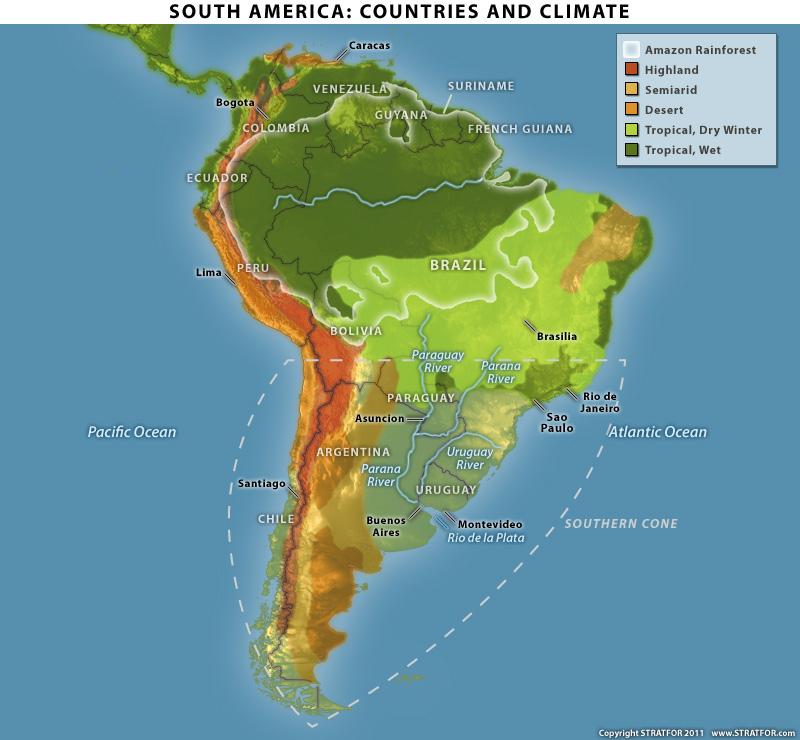
The combination of mountains and jungle greatly limits the degree to which states in this arc— from French Guiana in the northeast to Bolivia in the southwest —can integrate with each other or the outside world. In all cases, basic transport is extremely difficult; tropical diseases are often a serious issue; there are few good ports; agricultural development is both more labor and capital intensive compared to more traditional food-producing regions; humidity and heat hinder conventional grain production; and the ruggedness of the mountains raises the costs of everything.
Historically, the only way these states have achieved progress toward economic development is by accepting dependence on an external (and usually extraregional) power willing to provide investment capital. Without this, these states simply lack the capital generation capacity to meet their unique and staggering infrastructure challenges. Consequently, the broader region is severely underdeveloped, and the residents of most of these states are generally quite poor. While some may be able to achieve relative wealth under the right mix of circumstances, none has the ability to be a significant regional — much less global —power.
The second exception to the tropical dominance of South America is the temperate lands of the Southern Cone. Here, the summers are dry enough to allow traditional grains to ripen, while cooler weather — especially winter insect kills —limits the impact of disease outbreaks. Unlike the scattered populations of the Andean region, the Southern Cone is one large stretch of mostly flat, moderately watered territory. The bulk of that land lies in Argentina, with significantly smaller pieces in Uruguay, Paraguay and Brazil. The only remaining country on the continent is where the temperate Southern Cone overlaps with the Andean mountain zone: Chile, one of the world’s most physically isolated states. It takes longer to fly from Santiago to Lima than it does to fly from London to Moscow, and longer to sail from Santiago to Buenos Aires than it does from New York City to London. Chile consequently does not participate significantly in the politics of the Southern Cone.
In stark contrast to the mountains and jungle that dominate the majority of South America, the Southern Cone flatlands are the best land on the continent. Their flatness, combined with their natural prairies, lowers the cost of construction, and the temperate climate makes them rich agricultural zones. But the real advantage lies in the region’s river structure. The Parana, Uruguay and Paraguay rivers combined with the Rio de la Plata — a massive estuary that empties into the Atlantic between contemporary Buenos Aires and Montevideo — are all navigable for a great portion of their length.
Moving goods via water costs about 10 to 30 times less than moving the same goods by truck. Such riverine transport systems therefore generate massive amounts of capital with little difficulty compared to land-transport systems. Collectively, this river network overlaying the agricultural flatlands is known as the Rio de la Plata region.
These rivers are particularly valuable for agricultural regions such as the Rio de la Plata. Wheat, corn, soybeans and the like suffer from a weak value-to-bulk ratio— oftentimes transporting them great distances can only be done at an economic loss. Water transport allows for foodstuffs to cheaply and easily be brought not just downstream but to the ocean and then the wider world. Russia presents a strong contrast to the Rio de la Plata region. Its famines often directly result from the inability to bring foodstuffs to the cities efficiently because its navigable rivers are not well situated — meaning foodstuffs must be transported by truck or train.
The most important geographic fact on the continent is that the Rio de la Plata region’s rivers are navigable both independently and collectively via a system of canals and locks. Only the Greater Mississippi River network of North America has more kilometers of interconnected maritime transport options. This interconnectivity allows greater economies of scale, greater volumes of capital generation and larger populations, and it greatly enhances the establishment of a single political authority. In contrast, the separate rivers of the North European Plain have given rise to multiple, often mutually hostile, nationalities. Argentina controls the mouth of the Rio de la Plata and the bulk of the navigable stretches of river. This leaves the Uruguayans, Paraguayans and Brazilians at a disadvantage within the region. (Brazilian power is greater overall than Argentine power, but not in the critical capital-generating geography of the Rio de la Plata region.)
The Brazilian Geography
Most of Brazil’s territory does not lie within these Southern Cone lands. Instead, roughly one-third of Brazil’s 8.5 million square kilometers is composed of vast tracts of challenging jungle, with the Amazon Basin being the most intractable of all. While there are many potential opportunities to exploit minerals, they come with daunting infrastructure costs.
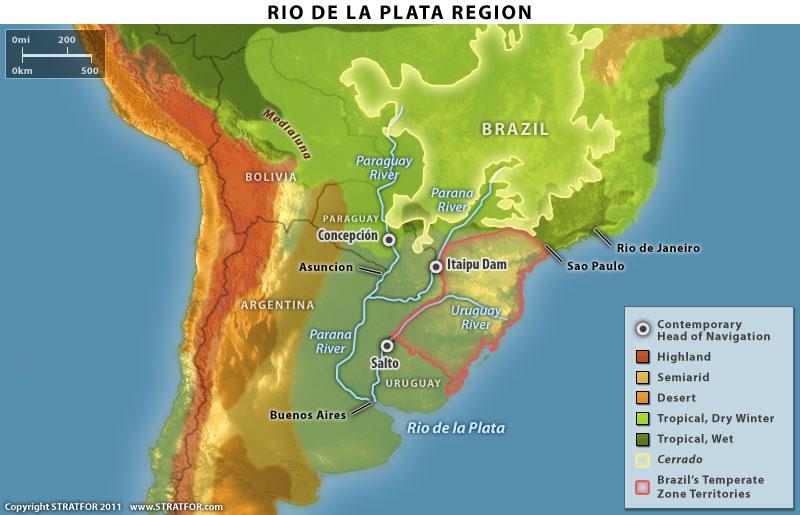
South of the Amazon Basin lies a unique region known as the cerrado, a vast tropical savannah with extremely acidic soils. However, because the heat and humidity is far less intense than in the jungle, the cerrado can be made economically viable by brute force. The cost, however, is extreme. In addition to the massive infrastructure challenges — the cerrado lacks any navigable rivers— the land must in essence be terraformed for use: cleared, leveled and fertilized on an industrial scale to make it amenable to traditional crops. There is also the issue of distance. The cerrado is an inland region, so shipping any supplies to or produce from the region comes at a hefty transport cost. Brazil has spent the greater part of the past three generations engaged in precisely this sort of grand effort.
Luckily for the Brazilians, not all of Brazil’s lands are so difficult. About 600,000 square kilometers of Brazil is considered traditionally arable. While this represents only 7 percent of the country’s total land area, that still constitutes a piece of arable territory roughly the size of Texas or France. All of that land lies in the country’s southern reaches. But much of that territory lies in the interior, where it is not easily accessible. Brazil’s true core territories are less than one quarter of this 7 percent, about the size of Tunisia, straddling the area where the tropical zone gives way to the temperate lands of the Southern Cone. These areas formed the core of Brazil’s original settlements in the early colonial period, and these lands formed the population core of Brazil for the first three centuries of its existence. As such, the topography of these lands has had an almost deterministic impact on Brazil’s development. Understanding that topography and its legacy is central to understanding what is empowering Brazil to evolve — and hampering Brazil from evolving— into a major power in the years to come.
Two obvious characteristics stand out regarding this core Brazilian region. First, it is semi-tropical, so development in the region faces a somewhat less intense version of the challenges described above for fully tropical zones. Second, and more critical, the Brazilian interior is a raised plateau — called the Brazilian Shield — which directly abuts Brazil’s Atlantic coast along nearly the entirety of the country’s southeastern perimeter. The drop from the shield to the Atlantic is quite steep, with most of the coast appearing as a wall when viewed from the ocean — the source of the dramatic backdrops of most Brazilian coastal cities. This wall is called the Grand Escarpment, and most Brazilian cities in this core region— Rio de Janeiro, Vitoria, Santos and Porto Alegre — are located on small, isolated pockets of relatively flat land where the escarpment falls to the sea.
The primary problem this enclave topography presents is achieving economies of scale. In normal development patterns, cities form around some sort of core economic asset, typically a river’s head of navigation (the maximum inland point that a sizable cargo vessel can reach) or a port or nexus of other transport options. The city then spreads out, typically growing along the transport corridors, reflecting that access to those transport corridors provides greater economic opportunities and lower economic costs. So long as somewhat flat land remains available, the city can continue growing at low cost. In time, nearby cities often start merging into each other, allowing them to share labor, capital, infrastructure and services. Economies of scale proliferate and such megacities begin generating massive amounts of capital and skilled labor from the synergies.
Megacities —such as New York City, Los Angeles, London, Paris, Tokyo, Buenos Aires, Istanbul and Shanghai — form the core of the global economic system. This "standard" development pattern has been repeated the world over. The premier American example is the "megalopolis" region of cities on the American Eastern Seaboard stretching from Washington to Boston, encompassing such major locations as Baltimore, Philadelphia, New York, Hartford and Providence. In Europe, a similar conglomeration contains the many cities of the German Rhine Valley. In both cases, major and minor cities alike merge into an urban/suburban conglomeration where the resources of each location are shared with and bolstered by the others. In all such cases, the common characteristic is the existence of land upon which to expand.
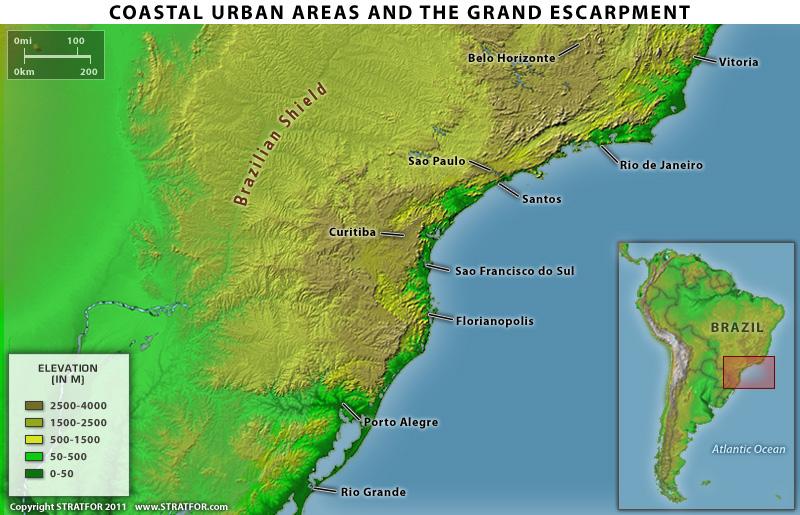
That land is precisely what Brazil’s core territory lacks. The Grand Escarpment comes right down to the ocean throughout the Brazilian southern coast. Brazil’s cities, therefore, are forced to develop on small enclaves of relatively flat land in the few areas where the escarpment has not pushed all the way to the sea. The lack of a coastal plain means no small cities can form between the major cities. Any infrastructure built by one city never serves another city, and linking the cities requires climbing up the escarpment onto the shield itself, traversing the shield and then going back down the escarpment to the other cities, a difficult and costly endeavor in terms of both time and engineering. Because Brazil does not have direct access to the navigable rivers of the Rio de la Plata region, it has to scrounge for capital to apply to this capital-intensive project. Absolute limitations on land area also drive up the cost of that land, injecting strong inflation into the mix right at the beginning and raising development costs. Enclavic geography is not something that can be "grown out of" or "developed around." The topography is constant, and these cities simply cannot synergize each other — a modern, low capital-cost city cannot be built on the side of a cliff. Moreover, since these enclaves are Brazil’s primary points of interaction with the outside world, they represent a constant, permanent restriction on Brazil’s ability to grow.
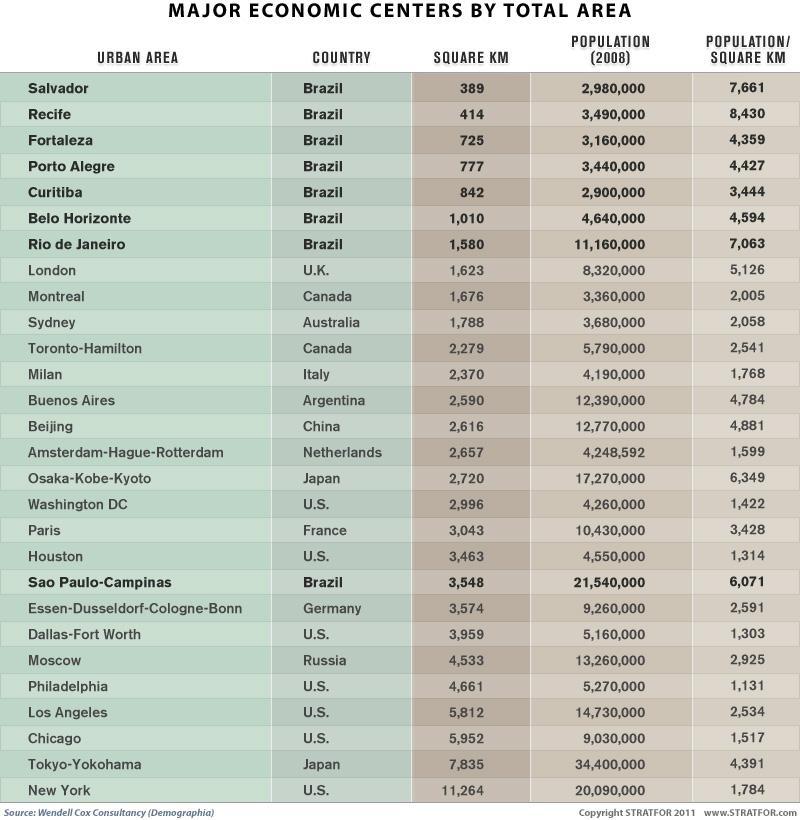
To this day, Brazil has very few major highways and railways because even where the topography does allow for the possibility, the costs still are much higher than in flatter lands farther south. The country lacks a major coastal road system, as the escarpment is simply too steep and too close to the coast. Following the Brazilian coastline makes clear how Brazil’s coastal roads are almost exclusively two-lane, and the coastal cities — while dramatic — are tiny and crammed into whatever pockets of land they can find. And most of the country is still without a rail network; much of that soy, corn and rice that the country has become famous for exporting reaches the country’s ports by truck, the most expensive way to transport bulk goods.
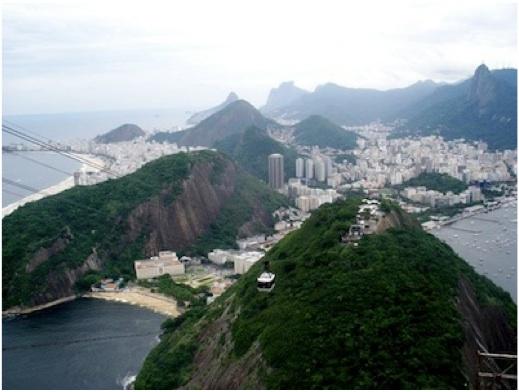
STRATFOR photo
The Grand Escarpment drops almost directly down to the coast in most portions of southern Brazil. This photograph vividly illustrates how the Grand Escarpment starkly limits Rio de Janeiro’s development. Brazil’s southern coastal cities have developed along similar patterns, lacking the traditional hinterlands of major cities elsewhere in the world.
The one exception to the rule is Sao Paulo state, centered on the city of the same name. Only Sao Paulo has sufficient flat lands to follow a more standard development pattern and thus achieve any economies of scale. It is also the only portion of Brazil that possesses anything resembling the modern, integrated infrastructure that follows more traditional development patterns. Unsurprisingly, this single state accounts for more than one-third of Brazil’s gross domestic product (GDP) despite only serving as home to one-fifth of the country’s population. As recently as 1950, Sao Paulo state produced more than one-half Brazil’s economic output.
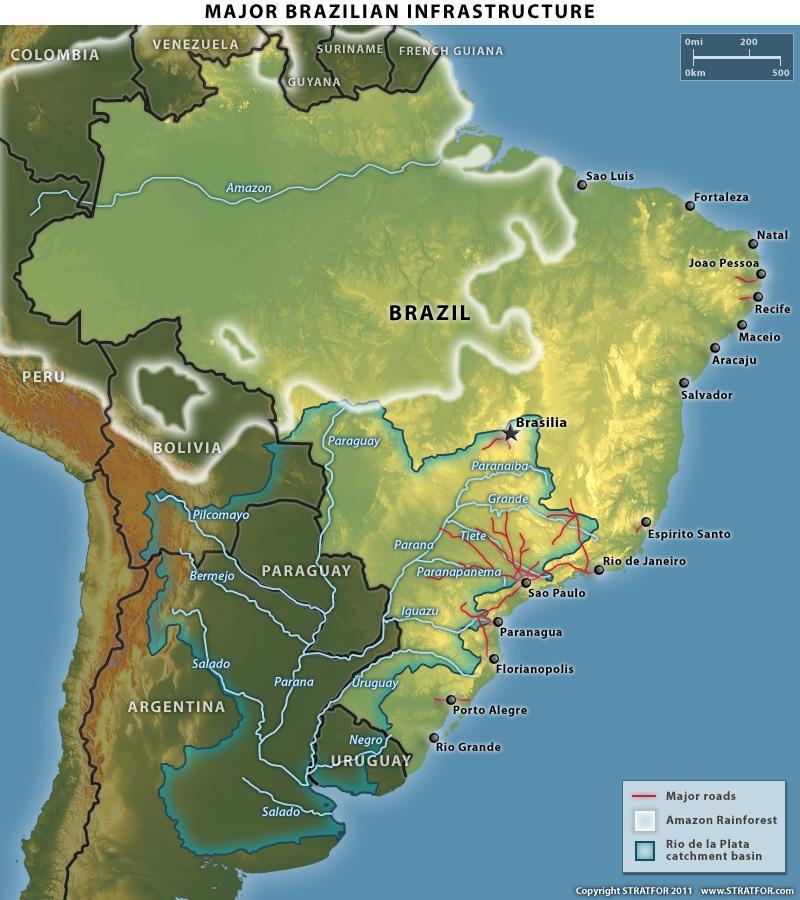
Unfortunately, Sao Paulo is not a coastal city. The escarpment at Sao Paulo is too steep and the coastal enclave — the port of Santos — is too small to take full advantage of Sao Paulo’s potential. Sao Paulo sits at an elevation of about 800 meters atop the Brazilian Shield, some 70 kilometers inland. (In comparison, the U.S. city at the Mississippi River’s head of navigation, Minneapolis, Minn., sits at less than 200 meters elevation despite being 3,000 kilometers inland.) This sharp elevation change helps mitigate the climatic impact of the region’s near-tropical conditions that predominate on the coast, but comes at the dauntingly high capital and engineering costs required to link the city and state to the coast. So while Sao Paulo is indeed a major economic center, it is not one deeply hardwired into Brazil’s coastal cities or to the world at large.
The lack of economies of scale and the difficulty of integrating local infrastructure forces bottlenecks. The worst of those bottlenecks occur where the coastal enclaves interact with the outside world — in Brazil’s ports — and it is here that Brazil faces the biggest limiting factor in achieving economic breakout. Brazil is correctly thought of as a major exporter of any number of raw commodities, but the hostility of its geography to shipping and the inability of its cities to integrate have curtailed port development drastically. The top seven Brazilian ports combined have less loading capacity than the top U.S. port, New Orleans, and all Brazilian ports combined have considerably less loading capacity than the top two U.S. ports, New Orleans and Houston.
Building a more sustainable Brazil cannot be done on the coast; there simply is not enough land there to feed a growing nation. But climbing up the Grand Escarpment to develop the interior introduces a new problem.
The coastal ridge at the top of the Grand Escarpment also divides drainage basins. Within a few dozen kilometers of the southeastern coast, South American rivers flow west, not east, ultimately emptying into the Rio de la Plata network. As the early Brazilian cities attempted to develop interior hinterlands, those hinterlands found themselves more economically intertwined with Argentine and Paraguayan lands to the south than with their parent communities to the east. For many in the interior it was cheaper, easier and faster to float products down the rivers to the megaport of Buenos Aires than to lug them by land up and over the Brazilian coastal mountain ranges and down the Grand Escarpment to the middling disconnected ports of coastal Brazil. Similarly, it was far easier to sail down the Atlantic coast and up the Rio de la Plata Basin onto the Parana than expend the cost of building on-land infrastructure. Brazil’s early efforts to develop integration within its own territories paradoxically led to an economic dependence upon its southern neighbors that weakened intra-Brazilian relationships.
Those southern neighbors took advantage of this situation, leaving Brazil struggling to control its own land. Unlike the U.S. independence experience, in which all of the colonies were part of the same administration and battled as one against their colonial overlord, South America was a patchwork of different entities, all of which fought for their independence in the same 15-year period. Paraguay achieved independence in 1811, Argentina in 1818 and Brazil in 1823. Immediately upon independence, the region’s new states struggled for control of the waterways that held the key to being the dominant, integrated economic power of the Southern Cone. Since Brazil was the last of the region’s states to break away from its former colonial master, it had the least time to consolidate in preparation for post-independence wars, and its enclave nature made such consolidation far more challenging than that of other Southern Cone states. Brazil accordingly did very badly in the ensuing conflicts.
Those early wars resulted in Uruguay’s separation from Brazil and the removal of Brazilian authority to above the heads-of-navigation on all of the Rio de la Plata region’s rivers. All of the rivers’ navigable lengths were now shared between Argentina, Paraguay and Uruguay, leaving capital-poor Brazil sequestered in its highland semi-tropical territories. Argentina and Paraguay rose rapidly in economic and military might, while Brazil languished with little more than plantation agriculture for more than a century.
The next two generations of regional competition focused on Argentina and Paraguay, which struggled for control of the Rio de la Plata maritime system. That competition came to a head in the 1864-1870 War of the Triple Alliance in which Argentina, Brazil and Uruguay eventually won after a brutal struggle with Paraguay. Fully 90 percent of the male Paraguayan population died in the conflict, nearly destroying Paraguay as a country; its demography did not finally rebalance until the 1990s. With Brazil’s wings clipped and its more serious regional rival all but destroyed, Argentina fashioned Paraguay and Uruguay into economic satellites, leveraging the region’s river systems to become a global economic power. By 1929 it had the world’s fourth-highest per capita GDP. Brazil, in contrast, remained impoverished and relatively isolated for decades.
Nor was Brazil united. Between the economic pull of Argentina and its rivers and the disconnected nature of the enclavic coast, regionalism became a major feature of Brazilian politics. Contact between the various pieces of Brazil was difficult, while contact with the outside world was relatively easy, making integration of all kinds — political, economic, and cultural —often elusive.
Regionalism remains a major issue in Brazilian politics, with strong rivalries triggering divisions among states and between states and the federal government. The preponderance of power at the beginning of the 20th century lay in the hands of the wealthier states, Minas Gerais and Sao Paulo. For many years, control of the central government alternated between the two states. This left Brazil’s remaining states isolated politically, prodding them to seek economic opportunities globally while defining their identities locally. For the better part of a century, "Brazil" was less a national concept as much as it was a geographic concept. Rio de Janeiro and Rio Grande do Sul states, for example, in many ways started acting like independent countries. This state of affairs lasted until very recently.
Brazil’s Inflation Trap
Brazil’s biggest problem — which began with the colonial settlement process and continues to the current day — is that it is simply not capable of growth that is both sustained and stable. Economic growth anywhere in the world is inflationary: Demand for arable land, labor, transport, capital and resources pushes the prices of all of these inputs up. Growth in most places can continue until those inflationary pressures build and eventually overtake any potential benefit of that growth. At that point, growth collapses due to higher costs and a recession sets in. Brazil’s burden to bear is that land, labor, transport infrastructure and capital exist in such extreme scarcity in Brazil that any economic growth almost instantly turns inflationary. Arable land, transport infrastructure and capital have already been discussed, but labor requires a more thorough examination, particularly given contemporary Brazil’s population of 194 million.
The labor issue is rooted in Brazil’s oligarchic economic system, something that also has a geographic origin. Brazil suffers from low capital generation and high capital costs — the opposite of most of the world’s economic power centers. In those power centers, the relative omnipresence of capital allows a democratization of economic power.
In the American experience, anyone could easily venture out of the cities into the lands of the Greater Mississippi Basin and, within a year or two, be exporting agricultural produce to both American and European cities. In Brazil, by contrast, massive amounts of capital were needed simply to build roads up the Grand Escarpment. The prospect of a common citizen establishing an independent economic existence in that sort of environment was unrealistic, as the only people who had the capacity to "build" Brazil were those who entered the country with their own pre-existing fortunes. So while the early American experience — and the industrialization that followed — was defined by immigrants from Europe’s rural poor seeking land, Brazil was started on its path by rich Portuguese settlers who brought a portion of their fortunes with them.
The American culture of small businesses long predates independence, whereas its Brazilian equivalent did not take root until the immigration waves of the late 19th century. As could be expected in a location where capital was rare but the needs for capital were high, these oligarchs saw no reason to share what infrastructure they built with anyone — not even with each other.
Complicating matters was that early Brazil did not have full access to that France-sized piece of arable land — most of it lay in the interior on the wrong side of the Grand Escarpment. The tropical climate drastically limited agricultural options. Until the mid-20th century, the only crops that could be grown en masse were plantation crops, first and most famously sugar, but in time coffee, citrus, bananas and tobacco. But unlike more traditional cereal crops that only require a few weeks of attention per year, such tropical crops are far more labor intensive in their planting, tending, harvesting and transport. Tobacco had to be cut and dried; sugar had to be cut, cooked and refined. Whereas a grain field can be quickly harvested and dumped into a truck, harvesting and transporting bananas, for example, takes much longer.
These characteristics impacted Brazil in two critical ways.
First, the capital required for these plantations was so great that smallholders of the American model were largely shut out. No smallholders meant no small towns that could form kernels of education and industrialization. Instead, plantations meant company towns where economic oligarchies gave birth to political oligarchies. In time, the political and economic power imbalance would provide the foundation for the Brazilian military governments of the 20th century. Even in modern times, Brazil’s geography continues to favor oligarchic plantation farming to family farming. At present, 85 percent of farms in the United States— a country with a reputation for factory farming — are 500 acres or fewer, whereas 70 percent of Brazilian farms are 500 acres or more.
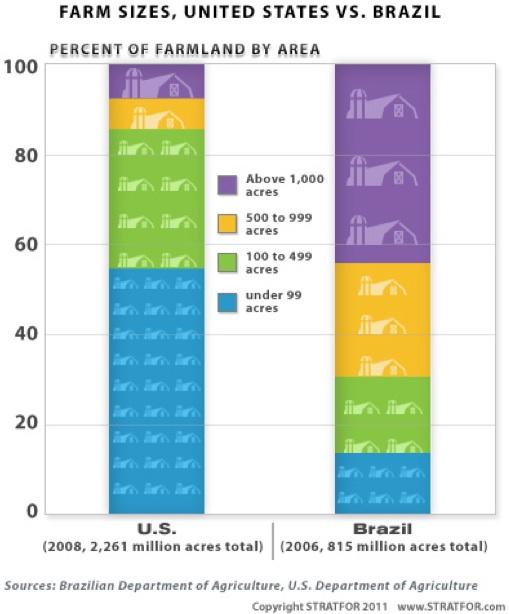
Time has not moderated this trend, but rather deepened it. In the latter half of the 20th century, Brazil launched a massive agricultural diversification effort that included the clearing of vast swaths of land in the interior, some of it in the cerrado and some as far inland as the Bolivian border. Among other agricultural products, some of these new lands were appropriate for corn and soybeans, crops normally quite amenable to farmers of a more modest capital base. But the cerrado requires massive inputs before agriculture can be attempted, and the interior lands are often in excess of 1,000 kilometers from Brazil’s perennially overworked ports. The twin development and infrastructure costs wound up reinforcing the oligarchic nature of the Brazilian agricultural system to the point that the average "new" Brazilian farm is six times the size of the farms of "old" Brazil.
Second, plantation agriculture calls for unskilled labor, a pattern that continues into the modern day. Unlike the more advanced New World colonies — which enjoyed access to easier transport and thus more capital, yielding the kernels of urbanization, an educational system and labor differentiation — Brazil relied on slave labor. It was the last country in the Western Hemisphere to outlaw slavery, a step it took in 1888.
A lack of skilled labor means, among other things, a smaller middle class and lower internal consumption than other states at a similar level of development. Consequently, Brazil has a small number of landed elite and a large majority of poor. As of 2011, fully one in four Brazilians eke out a living in Brazil’s infamous slums, the favelas. According to the Gini coefficient, a sociological measure of income inequality, Brazil has been the most unequal of the world’s major states for decades.
Taken together, Brazil faces inflationary barriers at every stage of the growth cycle. Starting a business requires capital, which is in short supply and held by a privileged class. Shipping goods requires scarce infrastructure, which is insufficient to needs, expensive and often owned by a privileged class. Any increase in demand for either of these inputs puts upward pressure on the associated costs. Expanding a business requires skilled labor, but there is not a deep skilled labor pool, so any hiring quickly results in wage spirals. And holding everything back is the still-disconnected nature of the Brazilian cities, so there are few economies of scale. More than anywhere else in the world, growth triggers inflation — which kills growth.
Consequently, Brazil has been characterized by below-average growth and above-average inflation for centuries and thus has traditionally been underindustrialized compared to most other developing states. Even before the oligarchs’ interests are factored in, any infrastructure projects that make sense will be linked to projects with good foreign cash-generating potential, which quickly narrows the list of likely projects to agriculture and mining (all commodities are U.S.-dollar denominated).
As such, Brazil has had little choice but to focus on the production or extraction of primary commodities such as sugar and iron ore. Such capital-intensive industries not only reinforce the oligarchic system but also skew the economy’s output. As of 2010, fully 70 percent of Brazil’s exports are dollar-denominated, with 45 percent of exports by value consisting of raw commodities. This may help Brazil’s (dollar-denominated) bottom line, but it does nothing to address its chronic infrastructure, labor, inequality or inflationary restraints.
It is thus unsurprising that Brazil has not yet emerged as a major global power. It cannot economically expand without killing itself with inflation. Its skilled labor pool and capital markets are woefully insufficient for its needs, and the oligarchs have a vested interest in keeping things that way. Even efforts to expand out of the country’s various traps have in many ways only entrenched the system. Moreover, what growth Brazil has enjoyed in recent years has been because of the combination of a broad rise in commodity prices and heavy foreign investment into Brazilian infrastructure to get at those commodities, not because of anything Brazil has done.
This hardly means that Brazil is either a failed state or that its past is condemned to be its future. What this does mean is that if Brazil is to rise as a major power something has to change. And two things have changed, in fact: Argentina, and the way Brazilians view their country.
Modern Argentina’s Decline
Argentina has everything necessary to become a major global power. Its lands are flat and temperate, its rivers are navigable and interconnected, and it enjoys the buffer of distance from major competitors and ample resources to fuel a rise to greatness. Indeed, throughout its first century of independence, Argentina moved from victory to victory — first over Brazil, then Paraguay, and then into the ranks of the world’s richest states. Standing in Argentina’s shadow, it is no surprise that Brazilians developed the tendency to be humble and passive, unwilling to challenge their rich and dynamic southern neighbor.
In the aftermath of the War of the Triple Alliance, Argentina enjoyed a historic boom. European immigrants arrived en masse, and the opportunities of the Rio de la Plata allowed for the creation and metabolization of massive amounts of capital. Alone among the Latin American states, Argentina generated a substantial middle class. But Argentina had two weaknesses, and from roughly 1930 on, Argentina’s trajectory has been downward.
First, unlike in Anglo America, land in Argentina was not widely distributed to individual landholders. Like elsewhere in Latin America, Argentina began with an oligarchic landholder system that left most of the population economically dependent on a small, wealthy elite. A successful backlash to this autocratic structure came in the form of labor unrest that propelled the populist Peron regime to power.
The legacy of Peronism is the enhancement of autocratic power by political mobilization of the lower and middle classes. This power has remained consolidated under the control of a leader whose authority is unquestioned and whose influence over the institutions of the state is near total. Other institutions are much weaker than the presidency, and as a result, policymaking in Argentina is highly dependent on the individual in power at any given time. Populist demands have overpowered more conventional policies for decades on end, resulting in Argentina’s slow and irregular decline for nearly a century.
Second, the vast distance of Argentina from the rest of the world greatly shaped Argentine perceptions. Tucked away at the bottom of the Atlantic, Argentina is one of the world’s most sequestered states. Once Brazil and Paraguay had been contained as local threats, the next closest threat to Argentina was the United Kingdom, some 12,000 kilometers away. As in the United States, such large distances allowed a large degree of cultural insulation and national savings. (There was no need to maintain a large standing military.)
But there is a critical difference between the two experiences. The Americans were some 7,000 kilometers closer to potential rivals and thus on occasion were reminded that they are not, in fact, alone. Events such as the 1814 burning of Washington, the European willingness to ignore the Union blockade during the Civil War, the 1941 bombing of Pearl Harbor and, most recently, 9/11 unsurprisingly have had a major impact on the American psyche. Each shocked the Americans out of complacency and spurred them to overreact to the sudden "surprise" that the rest of the world exists. In those subsequent spasms of activity, the Americans remake themselves. This process entails a great deal of disruption in the United States and abroad, but it keeps the Americans adaptable.
Argentina’s greater distance from world affairs means that they have suffered no such revivals following intrusions into their geographic utopia. The War of the Triple Alliance is now 140 years past. The war over the Falklands Islands, known to Argentines as the Malvinas, was the one notable instance in which Argentina sought interaction with the outside world. Buenos Aires initiated conflict with a far superior military power — the United Kingdom — and the resulting political and military defeat crushed the standing of the Argentine military, heavily contributing to the decline and fall of the military government. Although the Falklands War had a huge political impact, it did not pose the kind of challenge to Argentine core elements of prosperity that would require a concerted effort at reform and self-renewal. As a result, Argentina has neglected to address national problems that have crept up on it over the decades.
Recent developments underline this tendency. An economic crisis in 2001-2002 placed a new populist government in power that defaulted on the country’s debt, which freed Buenos Aires of the need to make interest payments. Rather than seize the opportunity to rebalance the Argentine economic and political system onto a sounder footing that leveraged the country’s geographic blessings, the state instead spent the savings on mass subsidies to bolster its populist credentials. High growth resulted, but the policies were only paid for by hollowing out the country’s capital stock and distorting the economy to the point where fundamental industries — from cattle farming to wheat growing to energy production — have now begun to fail. High taxes combined with high consumption encouraged by large subsidies and price controls have crippled business owners and agriculturalists alike. The subsidies have proved particularly problematic, as they have locked the government into ever-increasing expenditures expressly linked to the populist patronage the people demand as their right. Consequently, Buenos Aires only wields limited influence in South America and little to none beyond the continent.
With all that said, Argentina is still the power in South America with the clearest, most likely growth path. It still holds the Rio de la Plata’s river network and it still holds the Pampas, the best farmland in the Southern Hemisphere. What it cannot seem to figure out is how to make use of its favorable position. So long as that remains the case — so long as the natural dominant power of the Southern Cone remains in decline — other powers have at least a chance to emerge. Which brings us back to Brazil.
Modern Brazil’s Success
Brazil’s challenges are legion, but at core they are as simple as these two issues: Brazil’s geography works against it, and its economy is trapped by inflation. The Brazilians have spent decades struggling against these two facts, and in the past generation they have finally achieved significant progress.
Brazil’s Struggle With Geography
As discussed, Brazil’s core coastal territories present the country with a variety of difficulties that no amount of local development can overcome. Yet Brazil does sport a broad swath of arable land in its interior which is flatter, more temperate and largely unified topographically — the trick is uniting the coastal territories on the east side of the Grand Escarpment with the interior in a way that does not undermine the authority of the state. From the 1870s until the 1980s Brazilian development strategy therefore was relatively straightforward: expand the country’s infrastructure, kilometer by painstaking kilometer, into those interior arable zones. The sheer size of the territories that could be put under plow partially overcame the inflationary and transport bottlenecks that limited Brazil’s core coastal regions.
While early expansion certainly weakened central authority by encouraging economic links to Argentina, as that expansion built upon itself and developed economies of scale, interior Brazil became a formidable economic engine in and of itself. And while Brazil’s gaze still lingered on the attractiveness of the Rio de la Plata’s transport network, Brazil was sizable enough to have independent economic heft. Under those circumstances, association with coastal Brazil was an economic complication rather than an economic catastrophe.
By the 1970s several interlocking factors started solidifying the many interior success stories:
- Argentina’s deepening malaise lessened the attractiveness of the Rio de la Plata’s rivers.
- Brazil finally cleared enough interior lands so that more easily shippable conventional cereals were starting to be produced in large quantities, producing a more positive value-bulk ratio in the transport of Brazilian agricultural produce that somewhat eased its transport problem.
- Brazil’s interior expansion took it right up to the borders of Bolivia, Paraguay and Uruguay, and after some tentative moments, Brazilian infrastructure and capital started moving across the borders and integrating the agricultural lands of the border states into the broader Brazilian economy. Argentina did little to resist. Bit by bit Argentina lost influence in the three states and by 2011 all three have become de facto Brazilian economic satellites.
- Foreign investors saw sufficient potential in the Brazilian interior that they were willing to invest increasing sums of their own capital in underwriting both the country’s interior development projects and its efforts to assimilate the three border states.
Surprisingly, the clear-cutting of the interior provided the basis of Brazilian political liberalization. One of the many downsides of an oligarchic economic system is that politics tend to become as concentrated as wealth. Yet in clearing the land Brazil created artificial trade ways — roads — that allowed some Brazilians to strike out on their own (though they were not as efficient as rivers). Currently there are some 2.6 million landholders with farms of between 5 and 100 acres (anything less is a subsistence farm, while anything more verges into the category of high-capital factory farms). That is 2.6 million families who have a somewhat independent economic — and political— existence. Elsewhere in the world, that is known as a middle class. The environmental price was steep, but without this very new class of landholder, Brazilian democracy would be on fairly shaky ground.
The interior expansion effort solved none of the coastal bottleneck issues, but the constellation of forces certainly conspired to ease Brazil’s path. But perhaps the most important aspect of this interior push was that Brazil ceased to be simply a geographic concept. The rising importance of the interior — best symbolized by the relocation of the political capital to the interior city of Brasilia in 1960 — diluted the regional leanings of the coastal cities. The lands of the interior saw themselves first and foremost as Brazilian, and as that identity slowly gained credence, the government finally achieved sufficient gravitas and respect to begin addressing the country’s other major challenge.
Inflation
No economic strategy can allow Brazil to achieve the magic mix of locally determined, strong growth with low inflation. At most, Brazil can have two of the three. For most of the 20th century, Brazilian governments tended to favor growth as a means of containing social unrest and mustering resources for the government, even at the cost of inflation. But since inflation tends disproportionately to harm the poor, the already-wide income gap between the oligarchs and the rest of the population only widened. Since 2006, strong global commodity prices have allowed the Brazilian economy to grow fairly rapidly, but those commodity prices are based on factors wholly beyond Brazil’s control. As with every other commodity cycle, this one, too, will come to an end, triggering all the economic dislocation with which Brazilians are all too familiar.
Unless of course, the government changes the game — which it has done.
The macroeconomic strategy of the current regime, along with that of a string of governments going back to the early 1990s, is known colloquially as the "real plan" (after Brazil’s currency, the real). In essence, the strategy turned Brazil’s traditional strategy of growth at any cost on its head, seeking instead low inflation at any cost. Subsidies were eliminated wholesale across the economy, working from the understanding that consumption triggered inflation. Credit —whether government or private, domestic or foreign — was greatly restricted, working from the assumption that the Brazilian system could not handle the subsequent growth without stoking inflation. Government spending was greatly reduced and deficit spending largely phased out on the understanding that all forms of stimulus should be minimized to avoid inflation.
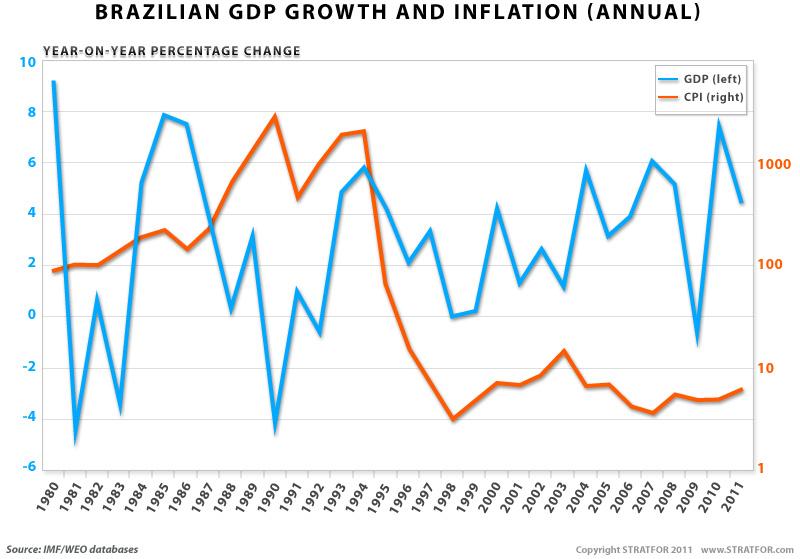
In practice, this led to a series of policies that most economists interpreted as rather orthodox, consisting of extremely low government debt; extremely restrained government activity; and extremely well capitalized, heavily regulated and conservative banks. These strict inflation control policies have achieved a high degree of economic stability. Inflation plunged from more than 2,000 percent a year to the single digits. But those gains came at a cost: Between 1980 and 2005, Brazil has shifted from one of the world’s fastest growing economies with one of the highest inflation rates to one of the lowest inflation economies with one of the lowest (if somewhat irregular) growth rates.
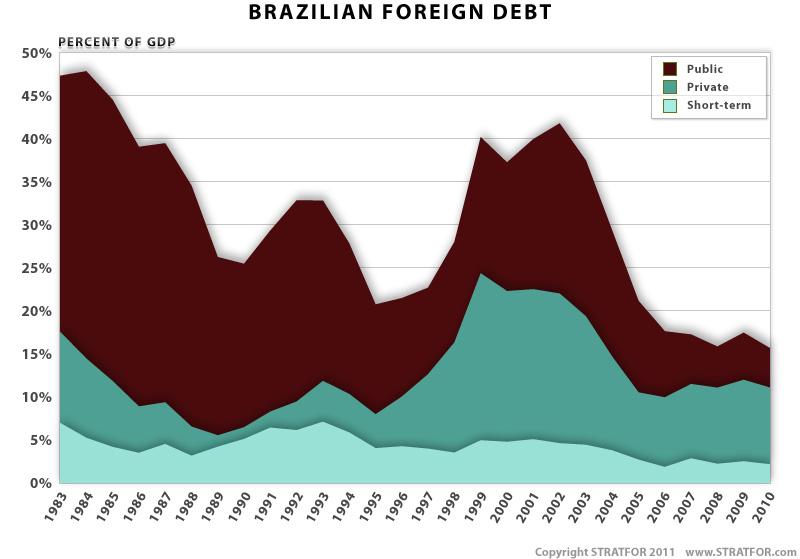
But the real plan is not an orthodox economic policy. Economic orthodoxy stems from the belief that constrained credit, limited government and low inflation are policy tools designed to maximize growth. Orthodox policies are means to an end. The real plan approaches the question from the other side, in which strong growth is the enemy because it causes runaway inflation that destroys economic, political and social stability. As such, constrained credit, limited government and low inflation are the goals of the real plan, not the means. The distinction is sufficiently critical to bear repeating: Growth is the enemy of the real plan, not its goal.
What results is not so much a difference between perception and reality but between what the Brazilian government intended and what the international markets perceive those intentions to be. Investors across the world believe the real plan’s ends are in actuality its means — and they interpret those ends as being in perfect sync with their interests. Thus, foreign investors have been voting for Brazil and the real plan with their money. Inward investment to Brazil is at historical highs, with the Brazilian Central Bank projecting the country’s 2011 foreign direct investment take at a stunning $60 billion.
All this money is working against the real plan’s goals: introducing credit where the government seeks to constrain credit, overfunding banks that the government wants to keep tightly regulated, encouraging spending that the government deems dangerous. Brazilians may be feeling richer because of the cheap, imported credit, but for government planners the environment is becoming ever more dangerous, threatening the hard-won stability that the real plan seeks to sustain. At the time of this writing, annualized inflation has edged up to 6 percent, right at the government’s redline.
The true success of the real plan lies in achieving economic stability and, most of all, control. Brazil’s geographic and social challenges are daunting, and no government could hope to address them competently if it could not first master local macroeconomic forces. In this, the real plan has performed to design. While hardly dead, inflation is restrained — and that has given the government space to start addressing the myriad other issues the country faces.
As with the interior expansion plan, the success of the real plan has changed how Brazilians feel about their country. When inflation burned through poor citizens’ savings, when it destroyed livelihoods and condemned tens of millions to lives of poverty, faith in central institutions was lacking. The real plan may not promise great growth or even great wealth, but it has delivered price stability — and with price stability people can lay at least a limited groundwork for their own futures. Savings holds value from year to year. Purchasing power is constant. These are basic economic factors that most of the developed world takes for granted but which are relatively new to the current generation of Brazilians— and Brazilians rightly credit their central government with achieving them.
Just as the interior expansion effort provided all of the Brazilian states with a vested political interest in the Brazil project, the real plan has provided all of the Brazilian states with a vested economic interest in the central government. It is not so much that the real plan removed the structural and geographic causes of Brazil’s inflation problem — which is impossible to do — but it proved to Brazilians that their country could be economically stable and that their government could act in the interests of Brazil in its totality rather than simply for whichever state happened to hold the presidency at the time.
Brazil’s Geopolitical Imperatives
Geopolitical imperatives are broad, strategic goals a country must pursue if it is to achieve security and success. These are non-ideological paths determined by the geography of a given country and by the geography of its neighbors. Geopolitical imperatives typically nest: The second imperative is dependent upon the first imperative, the third upon the second, and so on. This is not the case for Brazil, however.
Since Brazil occupies such a difficult geography, it has traditionally been a weak state that has lacked the resources and institutional capacity to greatly impact the world around it. Its first three imperatives reflect this. As such, the order in which those imperatives might be attained is largely determined by the constellation of forces in Brazil’s near abroad — factors for the most part beyond the Brazilians’ ability to manipulate — rather than any decision-making process in Brasilia. Brazil can only push to achieve these imperatives as circumstances beyond its control allow.
Imperative One: Protect the Coast
The Brazilian southern coast contains the country’s core territories. However, the ruggedness of that coast and the disconnected enclave nature of the core territories mean that infrastructure linking the coastal territories will not ensure mutual defense. The only way Brazil can protect its core itself is to cultivate a naval force of sufficient strength to deter would-be predatory powers. Without such a navy, Brazil would shatter into a series of (most likely mutually hostile) city-states. And without a navy any Brazilian exports are utterly at the mercy of more maritime-oriented entities.
But Brazil is capital poor and cannot afford such a navy. Historically, this has led Brasilia to seek alliances with whatever the dominant Atlantic power has happened to be in order to hold the traditionally more powerful Argentina in check. In the first half of the 19th century, the Brazilians sought out a favorable relationship with the British. But the deeper expression of this imperative came from Brazil’s enthusiastic embracing of the United States’ Monroe Doctrine. Nearly alone among Western Hemispheric powers, Brazil expressed enthusiasm for the American neo-colonial policy of barring European states from the Western Hemisphere, largely because it could not stand up to those powers without assistance.
Even today, Brazil’s navy is unable to patrol the Brazilian coastlinereliably beyond the Brazilian core territories. Thus, Brazil maintains close— if not exactly friendly — relations with the United States both to ensure that America never views Brazil as a state of concern and as a hedge against other potential threats.
Imperative Two: Selectively Expand into the Interior
Developing (or outsourcing) a navy is one means of protecting Brazil’s core. Another is to expand that core into new areas not so exposed to a hostile navy. In this, Brazil faces several challenges. The coastal enclaves are not large enough to generate their own economies of scale, so reaching inland requires the expenditure of massive resources Brazil simply does not have. As such, Brazil’s inland expansion has been halting, slow and piecemeal and driven by an often badly coordinated mix of government, oligarchic and foreign interests. The obvious target for this expansion is into the subtropical and temperate regions of the country’s south, not the tropical zone of the north.
However, the farther these new territories are from the coast, the more integrated they will naturally become into the capital-rich lands of the Rio de la Plata region to the south. Ironically, in achieving strategic depth and a better economic position, Brazil risks its territory becoming more fully integrated into its neighbors, as opposed to the Brazilian core.
In this challenge, however, also lies an opportunity. When the economies and populations of Brazil’s interior regions are small, they naturally gravitate toward Argentina’s sphere of influence. But as they grow they eventually reach a critical mass in terms of influence, which brings us to the third imperative.
Imperative Three: Expand into the Rio de la Plata Region
The solution lies in increasing Brazilian influence to the south so that those territories ultimately answer to Brazilian economic and political decision-making. Like the first two imperatives, this requires decades of slow efforts to make any progress. It has only been in the past generation that Brazil has created enough capital to encroach into the Argentine-Brazilian buffer states of Bolivia, Paraguay and Uruguay. Brazil has invested heavily into Bolivian energy and agriculture. Most Bolivian foodstuffs are now sold to or through Brazil to the outside world. Natural gas — responsible for by far the largest component of Bolivian state income— is under the direct management of Brazilian state-owned energy company Petroleos Brasileiros (Petrobras). In Paraguay, Brazilians have migrated in significant numbers and are the dominant investors in the economy —particularly in electricity, as the two are partners in the Itaipu Dam. Brazilian (and Argentine) cash fuels Uruguay’s vibrant financial sector, and Brazilian-born Uruguayan citizens now own a majority of Uruguay’s farmland.
The next logical question — something the normally nonconfrontational Brazilians are currently struggling with — is what to do once economic control has been seized but political control is not yet in place. Here the Brazilians come up against an odd cultural barrier: Nonconfrontation is hardwired into the Brazilian psyche. Even today, with the Brazilian economy growing and Argentina continuing to struggle, there exists a belief in government circles that Brazil needs to concentrate on striking an equilibrium with Argentina, with perhaps the inclusion of even Chile in a trilateral balance of power in the region (the Chileans for their part want little to do with the Southern Cone and even less to do with the Argentine-Brazilian balance of power).
For all practical purposes, Brazil has already secured dominance in the three buffer states— Uruguay, Bolivia and Paraguay are all but economic satellites of Brazil— but in light of Brazil’s historically passive foreign policy these states rarely shirk from demanding better terms out of Brasilia. Uruguay charges steep fees on Brazilian cargo. Paraguay recently was able to triple the cost of electricity produced by the Itaipu Dam, Brazil’s single-largest source of electricity, and routinely receives financial aid from Brazil and Mercosur. The Bolivian government regularly confronts Medialuna landowners who for all intents and purposes are fully integrated into the Brazilian economy, and it has not been shy about its attempts to nationalize energy assets owned by Brazilian interests. If Brazil is going to make its gains stick, at some point it will need to devise a strategy for formalizing its control of the buffer states. That means, among other things, learning to be less accommodating.
There also looms a much more significant — potentially bruising — competition. Brazil cannot be truly secure until at the very least it controls the northern shore of the Rio de la Plata. That requires significant penetration into Paraguay and de facto control of Uruguay and of select pieces of northern Argentina. Were that to happen, Brazil’s interior would have direct access to one of the world’s most capital-rich regions. The marriage of such capital generation capacity to Brazil’s pre-existing bulk will instantly transform Brazil into a power with global potential.
But not before. Without these territories, the Southern Cone balance of power remains in place no matter how weak Argentina becomes. So long as Argentina can exercise functional independence, it persists as a possible direct threat to Brazil, constrains Brazil’s ability to generate its own capital and exists as a potential ally of extraregional powers that might seek to limit Brazil’s rise.
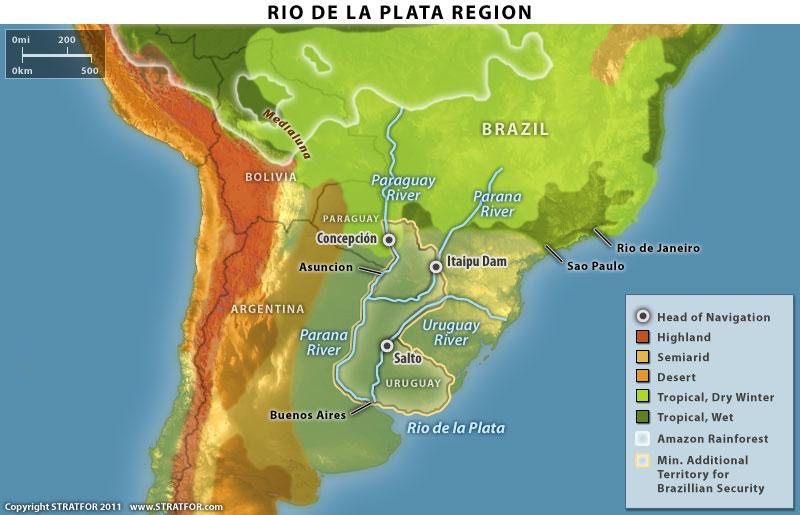
Imperative Four: Challenge the Dominant Atlantic Power
Should Brazil manage to consolidate control over the Rio de la Plata basin the game changes greatly. At this point Brazil is no longer a vulnerable, enclave-based state facing extreme challenges to its development. Instead, Brazil would control the majority of the continent and command broad swaths of easily developed arable land. Instead of cowering in fear of regional naval powers, it would be the dominant regional naval power. With that transformation, Brazil would not see extraregional navies as friends protecting it from Argentina but as enemies seeking to constrain its rise.
Obviously, this imperative will be well beyond Brazil’s reach for many decades. Not only is Brazil’s navy far smaller than that of states with one-third its population, it is nowhere close to commanding the Rio de la Plata region. Until that happens, Brazil has no choice but to align with whatever the Atlantic’s dominant power happens to be. To do otherwise would risk the country’s exports and its overall economic and political coherence.
Contemporary Challenges: Escaping the Trap
Contemporary Brazil faces three interlocking problems that pose severe structural challenges to all of the economic stability it improbably has attained: an overvalued currency, Mercosur and China.
As to currency, investor enthusiasm for Brazil’s recent stability and theoretical growth prospects has flooded the country with external funding. In addition to complicating always-critical inflation concerns, all that capital is having a demonstrable impact on the Brazilian currency, pushing the real up by more than 50 percent in just the past two years, and doubling it since 2003.
For Brazil’s commodity exports — all of which are dollar-denominated — this has no demonstrable impact, but for the country’s industrial exports this currency appreciation is disastrous. Because Brazil’s infrastructure is inadequate and the country is capital poor, Brazil produces very little that is high value-added; Such industries are the providence of capital-rich, low-transport-cost economies such as Germany and Japan. Instead, Brazil’s predominantly low- and medium-value-added industries compete heavily on price. A 50 percent increase in the currency largely guts any price competitiveness enjoyed by Brazil’s sheltered industries. The only Brazilian firms benefiting from the mix of impacts are those few high-skill firms that happen to price their products in U.S. dollars, most notably oil firm Petrobras and aerospace firm Embraer — which, while world class by any definition, are not representative of the broader Brazilian economic structure.
Second, Brazil has limited itself with the highly distorting and damaging trade network known as Mercosur. Recall that an oligarchy has long dominated the Brazilian economy, controlling most of the country’s scarce capital and enjoying a privileged economic and political position. Unlike most trade agreements — which are negotiated by governments on behalf of the corporate world — Brazil’s oligarchic background meant these oligarchs negotiated Mercosur on behalf of the Brazilian government.
This abnormal process radically changed the end result. A normal trade deal removes barriers to trade and exposes companies in all the affected countries to competition from each other. In Mercosur’s case, the various Brazilian industrialists were able to block off entir
© 2005-2022 http://www.MarketOracle.co.uk - The Market Oracle is a FREE Daily Financial Markets Analysis & Forecasting online publication.



